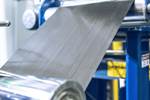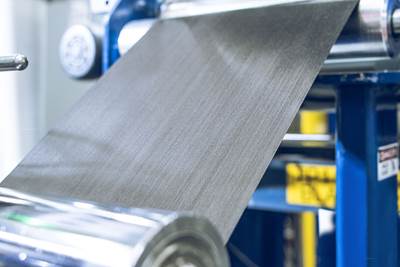VoltAero debuts Cassio 330 electric-hybrid aircraft
The first member in the Cassio airplane family offers a clean-sheet airframe design, proprietary hybrid propulsion and sustainable fuel operation. Flight testing and certification are anticipated for late 2023 into 2024.

The no. 1 Cassio 330 prototype is shown on VoltAero’s Paris Air Show exhibit stand at Le Bourget Airport. Photo Credit: VoltAero
VoltAero (Médis, France) has unveiled its first Cassio 330 electric-hybrid aircraft, the first member in an airplane family that brings together a clean-sheet airframe design with a proprietary hybrid propulsion system (more on this below). The no. 1 Cassio 330 prototype was introduced during a press conference with international journalists on VoltAero’s exhibit stand at the 2023 Paris Air Show.
“Today marks a true milestone for electric aviation, as VoltAero delivers on its promise to take an all-new approach for quiet, efficient and eco-friendly transportation that is based on a hybrid design combining thermal and electric propulsion for maximum flight safety,” Jean Botti, VoltAero’s CEO and CTO, says. “I want to thank my VoltAero team for its dedication and tireless work in reaching this historic moment, as well as express my appreciation to our suppliers and partners for their commitment to Cassio.”
The prototype is targeted to perform its maiden flight in late 2023. This aircraft will be used to validate the overall airframe configuration and aerodynamics of VoltAero’s all-new design for Cassio, and will be powered by a four-cylinder Kawasaki Motors (Tokyo, Japan) thermal engine derived from the company’s motorcycle engine products.
It will be followed by the no. 2 Cassio 330’s maiden flight in the second quarter of 2024. This aircraft will be used for the airworthiness certification program, and is to be equipped with VoltAero’s full-up hybrid propulsion unit — composed of the four-cylinder Kawasaki Motors thermal engine (with a peak power rating of 165 kilowatts) and a Safran (Paris, France) ENGINeUS smart electric motor (with a peak power rating of 180 kilowatts).
VoltAero has selected Akira Technologies (Bayonne, France) for the integration and validation of Cassio’s hybrid propulsion unit, including its gearbox, the unit’s mechanical integration and ground testing and test/adaptation of the Kawasaki thermal engine and Safran electric motor.
The Cassio 330 will have a four/five-seat interior configuration, followed by the six-seat Cassio 480 with a combined electric-hybrid propulsion power of 480 kilowatts, and the Cassio 600 — which is to be sized at a 10/12-seat capacity with electric-hybrid propulsion power of 600 kilowatts.
VoltAero is also pursuing the application of sustainable fuels for Cassio’s hybrid propulsion unit, including biofuel and liquid hydrogen. Currently, VoltAero’s Cassio S testbed aircraft is performing flight validations of VoltAero’s hybrid power unit with biofuel. And as part of its Paris Air Show exhibit, VoltAero displayed a Kawasaki Motors thermal engine that operates with liquid hydrogen, which will be used on Cassio 330 aircraft in the future.
The Cassio family product line will target regional commercial operators, air taxi/charter companies, private owners, as well as utility-category service for cargo, postal delivery and medical evacuation (Medevac) applications.
VoltAero will assemble the Cassio aircraft in a purpose-built facility at the Rochefort Charente-Maritime Airport in France’s Nouvelle-Aquitaine region.
Related Content
Welding is not bonding
Discussion of the issues in our understanding of thermoplastic composite welded structures and certification of the latest materials and welding technologies for future airframes.
Read MoreComposites manufacturing for general aviation aircraft
General aviation, certified and experimental, has increasingly embraced composites over the decades, a path further driven by leveraged innovation in materials and processes and the evolving AAM market.
Read MorePlant tour: Middle River Aerostructure Systems, Baltimore, Md., U.S.
The historic Martin Aircraft factory is advancing digitized automation for more sustainable production of composite aerostructures.
Read MorePlant tour: Albany Engineered Composites, Rochester, N.H., U.S.
Efficient, high-quality, well-controlled composites manufacturing at volume is the mantra for this 3D weaving specialist.
Read MoreRead Next
Sikorsky hybrid-electric VTOL demonstrator to inform future missions
Long-range, autonomous HEX aircraft prototype featuring a composite airframe serves as evaluation of large VTOL aircraft design, novel propulsion systems and control architectures for military and commercial purposes.
Read MoreEcoPulse demonstrator configuration is revealed in preparation for upcoming flights
Daher, Safran and Airbus cite recent milestones made with the composite hybrid-electric propulsion aircraft, progressing the project’s hybridization and decarbonization goals.
Read MoreDemonstrating composite LH2 tanks for commercial aircraft
Toray Advanced Composites and NLR discuss the Netherlands consortium and its 4-year project to build demonstrator liquid hydrogen tanks, focusing on thermoset and thermoplastic composites.
Read More

















.jpg;maxWidth=300;quality=90)








